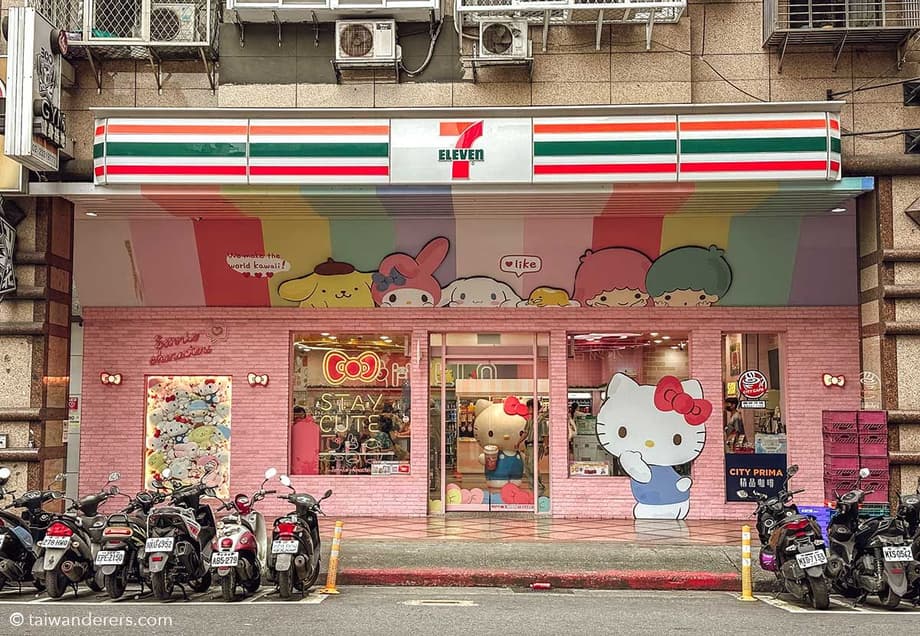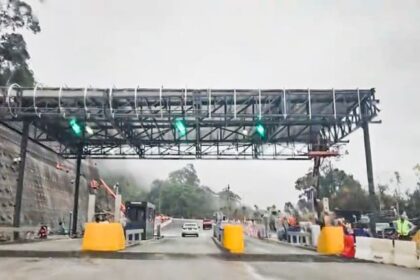A campus launch underscores a strategic bet
7-Eleven has opened its ninth unmanned convenience store in Taiwan at National Central University in Taoyuan, marking a new phase for grab and go retail on campuses. The 82 square meter outlet is packed with technology. About 140 ceiling cameras and optical radar work with artificial intelligence to identify what shoppers pick up, then charge them without barcode scans or lines. The company says the experience takes roughly 30 seconds from selection to checkout. The store also adds an automated pickup micro warehouse that sizes parcels and adjusts storage spaces on its own, a first for Taiwan, linking contactless retail with smarter last mile logistics.
Uni-President Group operates 7-Eleven in Taiwan and frames the unmanned push as a way to prepare for a tightening labor market, not a quick route to profit. Taiwan faces an aging society and a shrinking share of working age people. Retailers and restaurants across the island are testing automation to keep service levels steady while staffing becomes harder.
Uni-President Group Chair Lo Chih-hsien has been candid about the economics of trial stores that run with minimal on site staff. He describes the effort as a readiness plan for the next decade, rather than a margin booster today.
Before addressing the economics, Lo explained why the chain is moving ahead despite the early costs.
Unmanned stores do not make money, but we have to do them, not to save labor costs, but to prepare for a shortage of service workers.
The choice of a campus site fits the chain’s test and learn approach. Five of the nine unmanned locations sit inside universities, where early adopters are common and shopping baskets are simple. One 7-Eleven X-Store previously moved to National Kaohsiung University of Science and Technology and, according to the company, saw traffic triple and sales double compared with nearby street stores. That kind of lift is helpful during a pilot phase where hardware and software investments are heavy.
How the technology works without staff
Unmanned convenience stores use a mix of sensors, cameras, and software to automate tasks that cashiers and shelf staff typically handle. Customers enter, select items, and walk out, while the system assigns items to a shopper profile and triggers payment. The goal is a short, predictable visit with minimal friction. The new Taoyuan store relies on a computer vision system supported by optical radar that supplements the camera feed with depth and motion data, helping the platform track people and products more reliably.
Cameras and optical radar
Ceiling cameras carry most of the work in computer vision stores. They watch how hands interact with packages, cups, and prepared foods. Optical radar adds a view of distance and movement, which is useful when two shoppers reach for similar items or when a person briefly moves out of a camera’s line of sight. Together, these inputs help a model infer which product left which shelf, and who holds it. That is why the system can skip barcode scans and still close the tab in about half a minute. If the shopper returns an item, the model updates the basket automatically.
Smart shelves and sensors
7-Eleven is also testing a different track for automation that leans more on shelf sensors and less on vision. In a previous collaboration with the Industrial Technology Research Institute, the X-Store 7 pilot integrated smart shelves, weight sensors, infrared light curtains, ID confirmation, and customer positioning. A single remote worker could monitor stock levels, validate entries, and watch store hotspots in real time. That sensor driven approach lowers computation needs and can reduce the number of cameras required. It can also speed up deployment in small footprints, where wiring and calibration are simpler. The Taoyuan launch shows the chain is exploring multiple technical stacks, pairing camera heavy systems in some sites with sensor focused setups in others.
Balancing accuracy, speed, and cost sits at the heart of unmanned retail. Early retail pilots that relied on simple QR code exits or basic RFID often struggled with missed scans and shrink risk. Newer systems combine computer vision, shelf data, and spatiotemporal analysis to raise item recognition accuracy. Research on unmanned convenience stores highlights that convenience and ease of use encourage adoption, while privacy and security worries can slow it. Clear signs, visible support options, and a fallback payment area can help shoppers try the format with confidence.
Why campuses and industrial zones lead adoption
University campuses are a natural match for cashierless stores. Shoppers are frequent, tech comfortable, and typically buy a few items at a time, which keeps recognition tasks straightforward. Crowds cluster around class breaks, so a system that clears purchases in 30 seconds can shorten queues and extend peak capacity without adding staff. The company’s report of higher traffic and stronger sales after moving an X-Store into a university underscores the value of a captive audience that visits several times a week.
Industrial parks and office clusters are another fit. FamilyMart has said it is expanding its Tech Store 4.0 in Taoyuan’s Yangmei Industrial Park, where computer vision and contactless payments automatically bill customers as they exit. Sites like these have consistent flows during shift changes and lunch periods. They also feature fewer one off tourist shoppers, which makes it easier to refine the layout and train models on predictable baskets. Both chains are signalling that campuses, factories, and office zones are the earliest markets to support reliable staff light operation.
Convenience stores in Taiwan already act as daily hubs. They sell meals and snacks, handle bill payments at kiosks, print tickets, and support store to store parcel services. That cultural role helps new digital features stick. Adding an automated pickup micro warehouse to an unmanned store tightens the loop between e commerce and the corner shop, where customers are already used to collecting packages. The dynamic compartments in the new Taoyuan site, built with Industrial Technology Research Institute technology, adjust to parcel size to maximize capacity and shorten pickup time.
Taiwan’s labor squeeze is reshaping retail
A shrinking labor pool is changing how service businesses plan investments. Restaurants and small retailers report ongoing hiring challenges. Technology vendors now pitch integrated systems that reduce the number of front of house roles needed on a shift. In Taiwan’s food and beverage sector, for example, AI queue management, self checkout, and unified payments are being installed to let one person run more tasks at once. That same push is evident in convenience retail, where the draw of 24 hour operation is difficult to sustain without automation as night shift staffing thins.
Uni-President’s leadership says unmanned formats do not pay off today, but they offer a way to learn operations that could be standard later this decade. Industrial Technology Research Institute has also argued that AI and sensor driven stores can support residents in remote or under resourced areas with steady service and lower staffing requirements. The new campus store knits those goals together with a parcel system that can help nearby e commerce sellers reach students and staff faster.
What customers gain and what worries remain
For shoppers, the pitch is simple. Walk in, grab what you want, walk out, and get charged correctly. That saves time during class breaks or shift changes. It also trims the hassle for late night visits, when even short lines feel longer. The National Central University location promises a checkout flow of about 30 seconds, with the vision and radar system handling the recognition. Many unmanned formats also support entry validation and loyalty with a code in the retailer’s app, then allow card or mobile wallet payments without any extra step at the door. The parcel pickup micro warehouse adds another reason to visit, since a student can grab a package and a drink in one stop.
Studies of Taiwan’s unmanned stores suggest the technology acceptance model applies here. Perceived usefulness and perceived ease of use shape attitudes toward unmanned formats, and those attitudes affect the intent to shop. Perceived risk can dampen that intent. Researchers have found that men report higher perceived usefulness and ease of use scores, and women report higher perceived risk scores. Many consumers still prefer cash, which means operators need to offer multiple payment choices and make each step clear. In practice, that often means allowing tap to pay, QR payments, and app linked cards, as well as visible receipts in the app after each visit.
Privacy and accuracy are the other concerns. A ceiling full of cameras and movement sensors invites questions about what gets recorded and how long data is stored. Retailers can ease those fears by limiting retention, publishing plain language policies, and showing how support staff can help if an error occurs. The technical risk is misclassification in tight spaces, for example when two people pick similar items at once. Pairing optical radar depth cues with shelf signals reduces those edge cases, which is why many deployments use multiple sensing methods. Vendors that survived earlier waves of unmanned retail point to failures in simple QR or RFID pilots, and they argue that modern vision and space time models are more reliable at scale.
Competition, costs, and the playbook for growth
Taiwan’s two largest chains are testing different mixes of technology and placement. 7-Eleven is running camera heavy pilots like the Taoyuan campus store, along with sites that rely more on smart shelves and weight sensors. FamilyMart is expanding in industrial parks with a vision led format that completes payment as customers leave. Both see early traction in controlled environments where shoppers are repeat visitors. The sensor forward model can be less expensive to deploy and easier to scale to small spaces. The camera forward model can handle a wider variety of products and gestures without instrumenting every shelf. Chains will likely keep both options in play, matching costs and accuracy targets to each site’s basket size and traffic patterns.
The business case still hinges on volume and learning. Hardware, calibration, and software tuning create upfront costs. Ongoing model training, device maintenance, and remote oversight add recurring costs. Leaders in the space say the return shows up in more than the checkout line. Digital shelves, app entry, and computer vision produce a stream of data that can improve planograms, cut out of stock rates, and flag which corners of the store draw attention. The parcel micro warehouse ties a campus location into broader logistics, creating a physical touchpoint for online orders that can deepen loyalty. Global interest in automated retail continues, from Amazon’s Just Walk Out sites to sensor led pilots in Asia and Europe. Industry estimates forecast steady growth for unmanned convenience formats over the next few years as operators target campuses, offices, hospitals, and transit hubs where short visits are the norm and labor is tight.
At a Glance
- 7-Eleven opened its ninth unmanned store in Taiwan at National Central University in Taoyuan
- The 82 square meter site uses about 140 ceiling cameras and optical radar to recognize items without barcode scans
- Checkout takes about 30 seconds and payment completes without waiting in line
- The store includes Taiwan’s first automated pickup micro warehouse that resizes compartments to fit parcels
- Uni-President Group’s chair says the format is a long term response to labor shortages, not a short term profit play
- Five of the nine unmanned stores are on university campuses, where students adopt new formats faster
- FamilyMart is expanding a computer vision Tech Store 4.0 in an industrial park and plans more self service sites
- Academic studies find ease of use and usefulness drive acceptance, while perceived risk and privacy concerns remain












